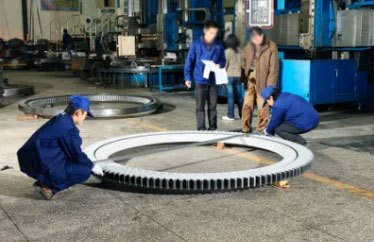Four-point contact ball slewing bearings
The field of mechanical engineering is vast, encompassing various types of bearings that play a crucial role in a wide range of applications. Among these, the four-point contact ball slewing bearing stands out for its versatility and reliability. This article aims to explore the design, features, advantages, and applications of these bearings, providing a comprehensive understanding of their significance in the engineering world.
Design and Features
Four-point contact ball slewing bearings are unique, rotary bearings that feature a circular inner and outer ring with a raceway designed to accommodate a series of balls. These balls form four points of contact with the raceway, resulting in a unique load distribution. A distinguishing aspect of these bearings is their ability to handle axial, radial, and moment loads simultaneously.

The design typically consists of the following elements:
Inner and outer rings: These two concentric rings form the foundation for the bearing's structure, providing a secure base for the balls to move in.
Rolling elements: The balls, made from high-quality materials like steel, ceramic, or hybrid materials, ensure smooth rotation between the inner and outer rings.
Cage: The cage holds the balls in place, ensuring their uniform distribution and preventing them from colliding with each other during rotation.
Seals: The bearing may include seals to protect the internal components from contamination and to retain lubrication.
Advantages
Four-point contact ball slewing bearings provide numerous benefits, including:
Compact design: These bearings have a slim profile, making them suitable for applications with limited space requirements.
Load capacity: Their unique four-point contact design allows them to handle complex loads effectively, making them ideal for heavy-duty applications.
Versatility: They can support axial, radial, and moment loads simultaneously, making them suitable for a wide range of applications.
Simplified installation: The design allows for easy installation and maintenance, reducing downtime and costs.
Applications
Four-point contact ball slewing bearings find applications across various industries, including:
Wind turbines: These bearings are used in wind turbine systems to support the main rotor shaft and handle the varying loads generated by wind forces.
Cranes: Slewing bearings are essential in crane systems, enabling the rotation of the boom and managing the immense loads generated during lifting operations.
Excavators: They are used in the rotation of the excavator's upper structure, allowing for smooth, precise movement while handling heavy loads.
Medical equipment: In medical devices like CT scanners and X-ray machines, these bearings enable precise positioning and rotation of the equipment.
Robotics: Slewing bearings are used in robotic systems for precise movement and load handling, making them vital components in advanced manufacturing and automation processes.
Conclusion
Four-point contact ball slewing bearings play a vital role in various applications across different industries. Their unique design, versatility, and load-handling capabilities make them a popular choice among engineers and manufacturers. As technology continues to evolve, these bearings will remain integral components in the development of advanced machinery and systems.
- Previous: Three row cylindrical roller slewing bearing
- Next: Crossed cylindrical roller slewing bearings













